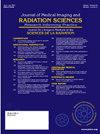Long term effects of gamma radiation on inflammatory and apoptotic biomarkers in nuclear medicine staff
IF 1.3
Q3 RADIOLOGY, NUCLEAR MEDICINE & MEDICAL IMAGING
Journal of Medical Imaging and Radiation Sciences
Pub Date : 2024-12-26
DOI:10.1016/j.jmir.2024.101832
引用次数: 0
Abstract
Background
Gamma radiation at low doses might have potential health effects in long-term exposure. The current study was aimed to search cell death pathway and inflammatory biomarkers in nuclear medicine workers with long-term exposure to gamma radiation.
Material and Methods
Fifty cases with a history of 10 years’ exposure to gamma radiation and 30 normal individuals were included in the current study. Blood samples were collected and then analyzed for gene expression of apoptotic markers, pro-inflammatory factor TNF-a, and antioxidant enzymes using Real Time PCR (RT-PCR) in both groups. Protein expressions were examined by Western blot and trace elements were analyzed using atomic absorption spectrometry.
Result
In exposed group, the expression of pro-apoptotic markers (CASP 8, CASP 3, Casp 9, and BAX genes), the pro-inflammatory factor TNF and antioxidant enzymes such as SOD, CAT, and GPX was increased in comparison with control group (P < 0.05). However, Bcl2 expression was decreased in exposed group. In addition, there was a significant and inverse correlation between serum levels of zinc and selenium in the exposed subjects compared to the control group (P < 0.05).
Conclusion
Our results revealed the potential role of low and chronic doses of gamma radiation in triggering apoptosis and inflammatory responses. However, more studies are needed to consolidate our findings.
γ辐射对核医学工作人员炎症和凋亡生物标志物的长期影响。
背景:低剂量的伽马辐射在长期照射下可能对健康产生潜在影响。目前的研究旨在寻找长期暴露于伽马辐射的核医学工作者的细胞死亡途径和炎症生物标志物。材料与方法:选取50例10年伽玛辐射暴露史患者和30例正常人作为研究对象。采集两组小鼠血液样本,采用实时荧光定量PCR (Real Time PCR, RT-PCR)检测细胞凋亡标志物、促炎因子TNF-a和抗氧化酶的基因表达。Western blot法检测蛋白表达,原子吸收光谱法分析微量元素。结果:暴露组促凋亡标志物(casp8、casp3、casp9、BAX基因)、促炎因子TNF、SOD、CAT、GPX等抗氧化酶表达均较对照组升高(P < 0.05)。暴露组Bcl2表达降低。此外,与对照组相比,暴露组血清锌和硒水平呈显著负相关(P < 0.05)。结论:我们的研究结果揭示了低剂量和慢性剂量γ辐射在触发细胞凋亡和炎症反应中的潜在作用。然而,需要更多的研究来巩固我们的发现。
本文章由计算机程序翻译,如有差异,请以英文原文为准。
求助全文
约1分钟内获得全文
求助全文
来源期刊

Journal of Medical Imaging and Radiation Sciences
RADIOLOGY, NUCLEAR MEDICINE & MEDICAL IMAGING-
CiteScore
2.30
自引率
11.10%
发文量
231
审稿时长
53 days
期刊介绍:
Journal of Medical Imaging and Radiation Sciences is the official peer-reviewed journal of the Canadian Association of Medical Radiation Technologists. This journal is published four times a year and is circulated to approximately 11,000 medical radiation technologists, libraries and radiology departments throughout Canada, the United States and overseas. The Journal publishes articles on recent research, new technology and techniques, professional practices, technologists viewpoints as well as relevant book reviews.
 求助内容:
求助内容: 应助结果提醒方式:
应助结果提醒方式:


